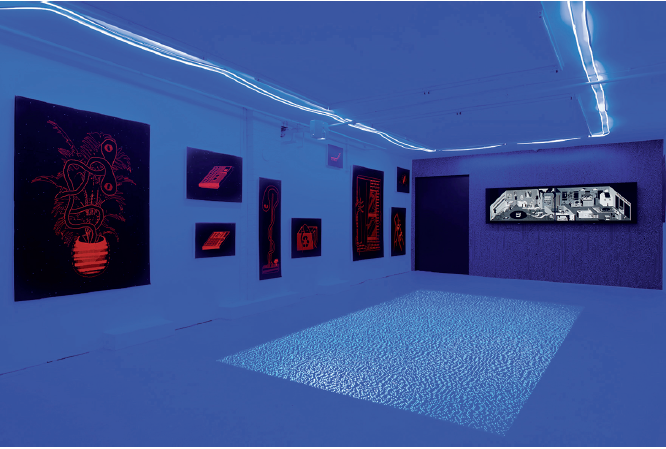Nicolas Sassoon
It’s easier to believe in magic, by which I mean power over one’s own life, at night. Also, I find, to actuate fate. Nicolas Sassoon’s animated works take place at night, or at least on a starry backdrop reminiscent of the night sky—both a void and its opposite. Sassoon is known for dreamy animations— for the most part softly moving, woven patterns—rooted in early computer graphics. This signature imagery is deceptively serene; while the animations themselves are meditative, each is simultaneously disquieting—poignant and dated, like time capsules unearthed too soon. A recent body of work uses these visual hallmarks to evoke the memory of semi-legal dance venues in Vancouver; incidentally, the first places I encountered Sassoon’s work. Incidentally, at night.
Sassoon exhibited “Index, Avenue, Skylight,” his ode to three Vancouver event spaces of the same names at Vancouver’s Wil Aballe Art Projects, a gallery space as clandestine as an after-hours party (access is via another gallery, down a set of outdoor stairs, beneath a balcony). Operating roughly from 2014 to 2016, these spaces formed, at one time, the locus of the city’s after-hours dance scene. Venues like these, in any city, operate with the knowledge of their inevitable obsolescence, making them almost perfect metaphors for both conceptual pillars of Sassoon’s project: technology and memory.

(left to right) Nicolas Sassoon, SPEAKER, BOOTH, LAPTOP, POSTER, CUPS, laser prints mounted on high-density foam, fluorescent pigments. Images courtesy Wil Aballe Art Projects, Vancouver.
Sassoon’s digital animations are, strictly speaking, GIFs, a file format that endlessly replays a set movement—repetition that is the visual equivalent of rumination. GIFs and loops (auditory or visual) are preludes to nothing. As such, they comprise their own, complete, world. After-hours venues are also worlds unto themselves, created as reprieves from the established and commercial. Sassoon picks up on the childlike verve that keeps these places going; the events and work created in these spaces were not designed to leave the confines of the space itself; the joy is in creation alone and validation is gained from a hyper-insular world. This is as liberating as it is limiting, and Sassoon depicts a world aware of its own precariousness, even revelling in decline. Operating, as they do, on the fringes means these spaces are largely undocumented. Without formal records of their existence, after-hours become suspended in time and subject to the caprices of memory. It is the afterlife of these venues Sassoon strives to remember, the quasi-magical ways they continue to exist as memories. There is something disorienting and playful about this approach, and ultimately pragmatic. The artist invites you to share, not a memory, which would be impossible, but a memory of a memory, which is beautiful.
The set piece of “Index, Avenue, Skylight” is an animation of the interior of each venue, with invented elements filling in the gaps in the artist’s recollection. These pieces (shown on “his and hers” wallmounted monitors) are paired with works on paper, specifically a fluorescent orange poster board meant to fade with time—material chosen for its capacity to slowly disintegrate and thus impersonate memory itself. Neon orange accents evoke cheaply distributed rave flyers; the colour glows under the gallery lighting like a turned-up screen and the bright figures float on a starry black backdrop. Elements from the animations are scaled-up and reproduced on paper: a space heater, a potted plant, stacks of empty cups. The aspects that are given priority appear to be random, the way that memory’s selective process can be mysterious; it’s unreliable but exhibits its own instinct for curation. Sassoon allows this instinct to guide his project, in which evocative power is prized over accuracy.

Installation view, “Index, Avenue, Skylight,” 2018, Wil Aballe Art Projects.
“Index, Avenue, Skylight” memorializes highly specific, dead venues. In applying his signature aesthetic to a concrete subject, he crystalizes its evocative potential, but may also narrow the audience. The question of whether Sassoon’s depiction of a semi-exclusive scene maintains its emotional resonance for the uninitiated is somewhat resolved by the loose fuzziness of this depiction. The headachy moiré patterns he is known for are folded into new dreamscapes, as brick walls, billowing curtains and flickering screen savers, providing a shimmering, widely recognizable foundation. As a collective memory, early computer graphics are unique; unlike other things that bond large groups of people—historic events, popular music or superstition—the imagery of the Internet, circa ’95, is free of specific emotional associations, a shared memory about which the only consensus is that it is a memory. In Sassoon’s hands this imagery becomes a byword for memory itself.
“Index, Avenue, Skylight” takes place in a darkened gallery space— mimicking nighttime and also the titular venues, which were similarly hidden gallery-esque spaces. The effect is a gentle time warp. In one piece an anthropomorphized clock is paused, mid-run. This figure, time both frozen and in flight, could be the show’s emblem. It’s also a too-obvious-to-miss visual pun: time is shown running out the door. Nights never last as long as they should, especially good ones. Sassoon’s project is a dream of the past. The places that lend themselves best to dreaming are outside of time or space—like the Internet or a fleeting after-hours venue—and it is here that Sassoon situates his practice.
The animations softly flicker. A gauzy, rippled pattern, hazy as the constantly fluctuating realms of memory, is projected on the gallery floor. Moments can be frozen in time, but they always, eventually, melt away. Sassoon shows these spaces as already partly eroded memories, foggy and oddly familiar. These are dreamscapes informed by memory, and, like all dreams, are unconscious and traffic in the collective in which they share. ❚
“Index, Avenue, Skylight” was exhibited at Wil Aballe Art Projects, Vancouver, from January 25 to March 3, 2018.
Meredyth Cole is a writer and editor living in Vancouver.

